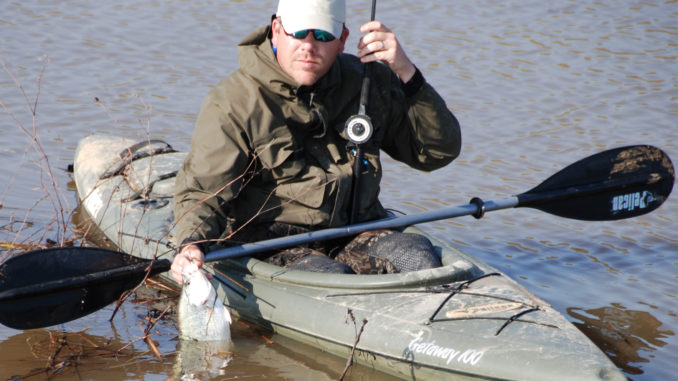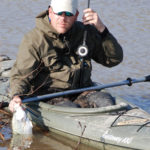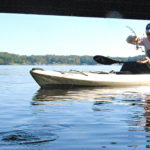
Grandpa would be proud of fillets from kayaks
Styles of fishing change over time. Seldom does the way Grandpa did it still prevail. Of all the styles and methods of fishing passed from one generation to the next, the one that has probably seen the most drastic changes is crappie fishing.
In the old days, during March when crappie started their annual spawning ritual, Grandpa would take a few days off and head over to the Santee Cooper lakes. From one of the burgeoning fish camps that were popping up around the lakes at that time, he’d rent a small wooden boat, whose only mode of propulsion was a wooden paddle. He would paddle up to one of thousands of cypress trees and knees that grew around the lake and dangle a live minnow on a hook around the base of the tree. By the end of the weekend, he’d have a cooler full of fresh crappie filets.
Somewhere along the line, somebody decided that two rods were better than one, and that plastic jig-skirts made better crappie bait. Today, the old wooden skiff has been replaced with a sleek fiberglass boat, complete with metal rod holders and state-of-the-art electronics, navigation and livewell systems. A modern crappie-fishing tournament looks like a giant waterbug convention, each boat sporting long graphite legs as the boats troll slowly round in circles.
Robert Vaughn of Eastover remembers the old days. During his youth, he enjoyed countless fishing forays with his grandfather, fishing for everything that swam in the Santee Cooper lakes. A couple of years ago, Vaughn discovered kayaks and realized that what worked back in the old days would probably still work today. Now, he is a part-time kayak-fishing guide and operates SC Kayak Fishing Adventures (803-669-6776) on Lake Murray, the Santee Cooper lakes and several rivers in between.
“When kayak-fishing for crappie, I mainly fish the upper areas of Lake Marion, from I-95 to Sparkleberry,” Vaughn said. “The better locations are creek channels that wind through the standing timber.”
Like Grandpa, Vaughn’s bait-of-choice is a live minnow, which he fishes under a slip cork. He employs either a floating minnow bucket or a home-made bait tank he fashioned from an air-tight dog-food container, complete with a C-cell battery operated aerator.
“The container has an angled mouth to make it easier to reach, and the whole setup fits easily into the tankwell of the kayak behind me,” said Vaughn.
Properly rigged, he paddles along the creek channels, dipping the minnow around the structure until he defines a pattern.
“During March, crappie will stage in different areas along primary and secondary channels,” he said. “Once you figure out the pattern, they become easier to catch.”
Though his plastic boat may seem space-aged compared to Grandpa’s rented skiff, Vaughn still enjoys a dinner of crappie filets, which gives him time to reflect on a great day of Palmetto Paddling.
Quick Draw Crappie
Another aspect of crappie fishing that has also changed is the habitat itself. Development along reservoirs and lakes has cleared away most of the natural spawning habitat. Fortunately, crappie have adapted and utilize man-made structure in the form of boat docks and piers to replace some of the lost spawning habitat.
Boat docks and piers make top-notch fish-holding structures, but the can be difficult to fish using conventional techniques. A savvy kayak angler with proper “dock-shooting” skills can turn a row of docks into a day of action.
“Shooting” is a casting technique that utilizes the action of the rod to slingshot the bait beneath overhead structure and lends itself well to the kayak. In this case, a water-level perch is an advantage. Shooting requires the use of a fa-action spinning rod and reel. For bait, mini-jigs outfitted with soft-plastic trailers or hair are easy to skip across the water’s surface to reach the far recesses of the target structure.
The best fishing rods for shooting are 5½-foot, ultralight graphite models. To execute the shot, leave two feet of line dangling from the rod tip and grasp the bait by the bend of the hook with the thumb and index finger of your free hand, making sure to keep your other fingers out of the way. Open the bail on the reel and apply tension to the line with the index finger of the hand holding the rod. Pull the bait down and back toward your body and extend the rod forward, causing the rod to bow over in the middle.
Targeting is instinctual, similar to shooting a long bow. You can “aim” the rod by looking down the spine, but practice and experience quickly builds muscle memory and hand/eye coordination. Shoot by releasing the jig, which snaps the rod tip forward, launching the bait toward the target. With proper timing, the line is then released from the other hand just after the shot, allowing line to peel off the reel without impeding travel.
Boat positioning is critical to getting off good shots at docks or other structure. Kayaks outfitted with anchor trolleys or anchor poles can anchor upwind, holding the kayak in position while you fire away. A breakaway system has saved the day on many occasions when a big fish got the hook and required extra space to fight. Make sure to keep the tag end of the anchor line close and your paddle closer for just such an event.







Be the first to comment